A Method for Riverway Erosion and Deposition Calculation Using Measured Cross-Sections
Abstract
:1. Introduction
2. Riverway Erosion and Deposition Calculation Method
2.1. Data Preparation
2.2. Thalweg Generation
2.3. Riverway Grid Division
2.4. Riverway Grid Node Elevation Interpolation
2.5. Riverway Erosion and Deposition Calculation
3. Results
4. Discussion
4.1. Comparison with the Cross-Section Method
4.2. Grid Size Sensitivity Analysis
4.3. Impact of the Distance between Adjacent Cross-Sections on Calculation Accuracy
5. Conclusions
Author Contributions
Funding
Data Availability Statement
Conflicts of Interest
References
- Angelakis, A.N.; Capodaglio, A.G.; Valipour, M.; Krasilnikoff, J.; Ahmed, A.T.; Mandi, L.; Tzanakakis, V.A.; Baba, A.; Kumar, R.; Zheng, X.; et al. Evolution of Floods: From Ancient Times to the Present Times (ca 7600 BC to the Present) and the Future. Land 2023, 12, 1211. [Google Scholar] [CrossRef]
- Yin, Z.; Zhang, H.; Tan, G.; Lyu, Y.; Feng, Z.; Shu, C.; Wang, J.; Zhang, G. Operating Effects of the Three Gorges Reservoir on the Riverbed Stability in the Wuhan Reach of the Yangtze River. Water 2021, 13, 3353. [Google Scholar] [CrossRef]
- Yang, Z.; Duan, X.; Huang, J.; Dong, Y.; Zhang, X.; Liu, J.; Yang, C. Tracking long-term cascade check dam siltation: Implications for debris flow control and landslide stability. Landslides 2021, 18, 3923–3935. [Google Scholar] [CrossRef]
- Han, D.; He, Z.; Lin, Y.T.; Wang, Y.; Guo, Y.; Yuan, Y. Hydrodynamics and sediment transport of downslope turbidity current through rigid vegetation. Water Resour. Res. 2023, 59, e2023WR034421. [Google Scholar] [CrossRef]
- Zhou, M.; Xia, J.; Deng, S.; Shen, J.; Mao, Y. Modelling of phosphorus and nonuniform sediment transport in the Middle Yangtze River with the effects of channel erosion, tributary confluence and anthropogenic emission. Water Res. 2023, 243, 120304. [Google Scholar] [CrossRef] [PubMed]
- Azarang, F.; Telvari, A.; Sedghi, H.; Bajestan, M.S. Numerical simulation of flow and sediment transport of Karkheh river before the reservoir dam construction using MIKE 11 [a case study in Iran]. Adv. Environ. Biol. 2014, 8, 979–989. [Google Scholar]
- Adib, A.; Foladfar, H.; Argashi, N. Application of Fluvial-12 model for calculation of maximum deformation in cross sections of tidal rivers (the Karun River in Iran). Acta Sci. Technol. 2019, 41, e39539. [Google Scholar] [CrossRef]
- Shu, C.; Tan, G. Advances in calculation methods for river sedimentation. J. Sediment. Res. 2009, 68–73. (In Chinese) [Google Scholar] [CrossRef]
- Dong, Y.H. Contrast study on Estimation of River Deposition Erosion Amount by Sediment Budget Method and Morphological Change Method. J. Yangtze River Sci. Res. Inst. 2009, 26, 1. (In Chinese) [Google Scholar]
- Duan, G.; Peng, Y.; Guo, M. Comparative analysis on riverbed erosion and deposition amount calculated by different methods. J. Yangtze River Sci. Res. Inst. 2014, 31, 108. (In Chinese) [Google Scholar]
- Zhang, R.; Wang, Y.; Han, Q.; Wu, B.-S. Calculation methods for erosion and deposition based on sediment balance equation in the Lower Yellow River. J. Sediment Res. 2018, 43, 21–27. (In Chinese) [Google Scholar]
- Antoine, G.; Camenen, B.; Jodeau, M.; Némery, J.; Esteves, M. Downstream erosion and deposition dynamics of fine suspended sediments due to dam flushing. J. Hydrol. 2020, 585, 124763. [Google Scholar] [CrossRef]
- Guo, Q.; Zheng, Z.; Huang, L.; Deng, A. Regularity of sediment transport and sedimentation during floods in the lower Yellow River, China. Int. J. Sediment Res. 2020, 35, 97–104. [Google Scholar] [CrossRef]
- Zhang, S.; Hu, X.; Miao, W.; Xu, Z. Analysis of the sediment sources of flood driven erosion and deposition in the river channel of the Fu River Basin. Int. J. Sediment Res. 2023, 38, 653–661. [Google Scholar] [CrossRef]
- Yang, Y.; Zhang, M.; Zhu, L.; Zhang, H.; Liu, W.; Wang, J. Impact of the operation of a large-scale reservoir on downstream river channel geomorphic adjustments: A case study of the Three Gorges. River Res. Appl. 2018, 34, 1315–1327. [Google Scholar] [CrossRef]
- Yang, Y.; Zheng, J.; Zhang, M.; Zhu, L.; Zhu, Y.; Wang, J.; Zhao, W. Sandy riverbed shoal under anthropogenic activities: The sandy reach of the Yangtze River, China. J. Hydrol. 2021, 603, 126861. [Google Scholar] [CrossRef]
- Liu, X.; Shi, C.; Zhou, Y.; Gu, Z.; Li, H. Response of Erosion and Deposition of Channel Bed, Banks and Floodplains to Water and Sediment Changes in the Lower Yellow River, China. Water 2019, 11, 357. [Google Scholar] [CrossRef]
- Xia, J.; Deng, S.; Zhou, M.; Lu, J.; Xu, Q. Geomorphic response of the Jingjiang Reach to the Three Gorges Project operation. Earth Surf. Process. Landf. 2017, 42, 866–876. [Google Scholar] [CrossRef]
- Yuan, X.; Tian, F.; Wang, X.; Liu, Y.; Chen, M.T. Small-scale sediment scouring and siltation laws in the evolution trends of fluvial facies in the Ningxia Plain Reaches of the Yellow River (NPRYR). Quat. Int. 2018, 476, 14–25. [Google Scholar] [CrossRef]
- Lyu, Y.; Zheng, S.; Tan, G.; Shu, C.; Han, Q. Morphodynamic adjustments in the Yichang–Chenglingji Reach of the Middle Yangtze River since the operation of the Three Gorges Project. Catena 2019, 172, 274–284. [Google Scholar] [CrossRef]
- Liu, W.; Wang, S.; Sang, Y.F.; Ran, L.; Ma, Y. Effects of large upstream reservoir operations on cross-sectional changes in the channel of the lower Yellow River reach. Geomorphology 2021, 387, 107768. [Google Scholar] [CrossRef]
- de Sousa, L.S.; Raude, J.M.; Wambua, R.M.; Mutua, B.M. Bathymetry changes caused by sedimentation in an unlined canal of the Chókwè irrigation scheme, Mozambique. Irrig. Drain. 2022, 71, 783–803. [Google Scholar] [CrossRef]
- Xu, H.; Xia, Y.F.; Wen, Y.C. Study on Characteristics of River Evolution of Chengtong Reach in the Lower Reach of the Yangtze River before and after Operation of the Three Gorges Project. In APAC 2019, Proceedings of the 10th International Conference on Asian and Pacific Coasts 2019, Hanoi, Vietnam, 25–28 September 2019; Springer: Singapore, 2020; pp. 745–749. [Google Scholar]
- Kou, Y.; Wang, N.; An’an Chen, K.L. Monitoring Variation of Glaciers Based on Remote Sensing Images in the Chenab Basin, Western-Himalaya, 1993~2016. Remote Sens. Technol. Appl. 2020, 35, 712–722. [Google Scholar]
- Schepaschenko, D.; See, L.; Lesiv, M.; Bastin, J.F.; Mollicone, D.; Tsendbazar, N.E.; Bastin, L.; McCallum, I.; Bayas, J.C.L.; Baklanov, A.; et al. Recent advances in forest observation with visual interpretation of very high-resolution imagery. Surv. Geophys. 2019, 40, 839–862. [Google Scholar] [CrossRef]
- Zhao, B.; Liu, Y.; Wang, L. Evaluation of the Stability of Muddy Coastline Based on Satellite Imagery: A Case Study in the Central Coasts of Jiangsu, China. Remote Sens. 2023, 15, 3323. [Google Scholar] [CrossRef]
- Xia, M.; Cui, Y.; Zhang, Y.; Xu, Y.; Liu, J.; Xu, Y. DAU-Net: A novel water areas segmentation structure for remote sensing image. Int. J. Remote Sens. 2021, 42, 2594–2621. [Google Scholar] [CrossRef]
- Pan, Y.; Xia, J.; Yang, K. A method for digital terrain reconstruction using longitudinal control lines and sparse measured cross sections. Remote Sens. 2022, 14, 1841. [Google Scholar] [CrossRef]

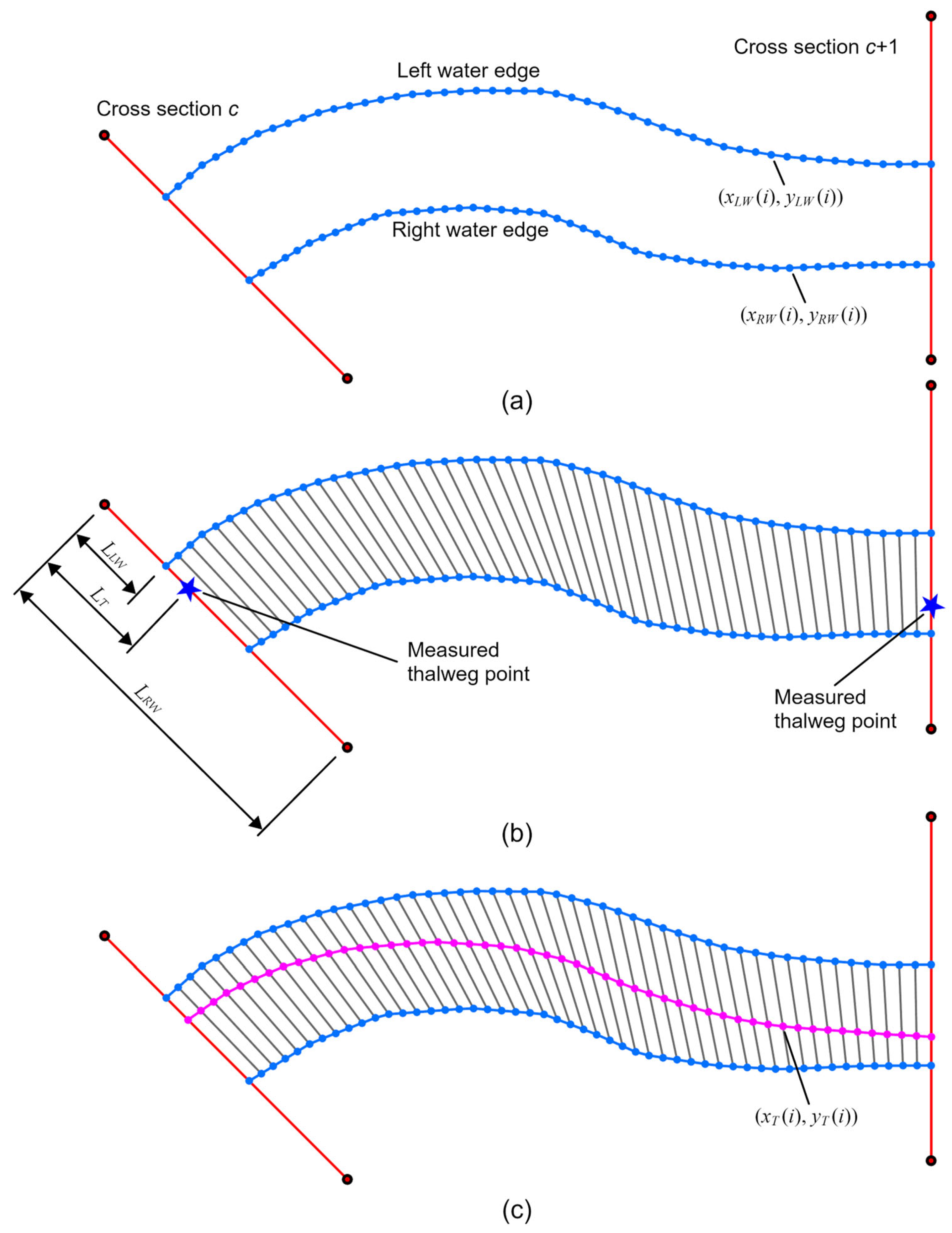


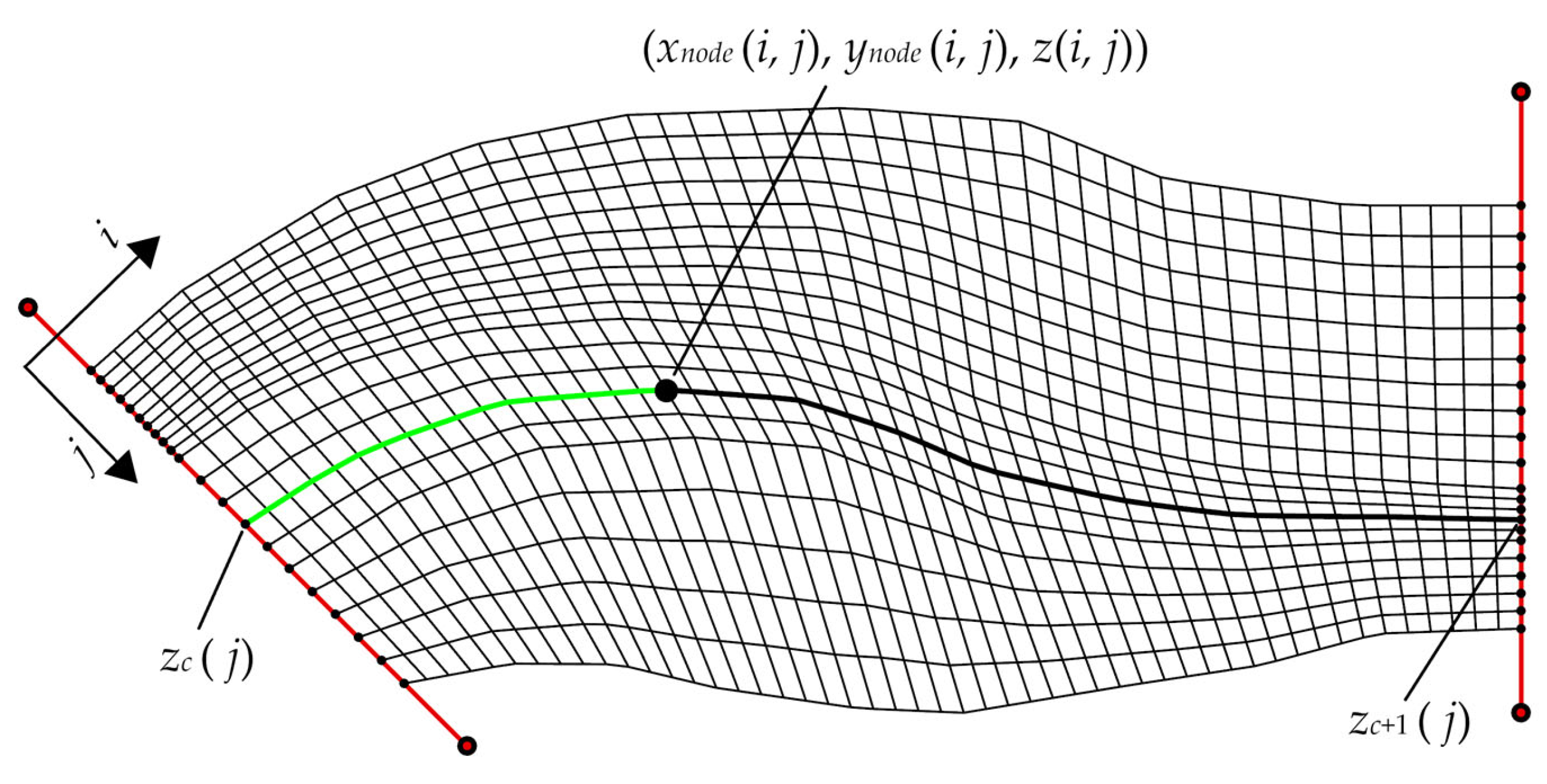
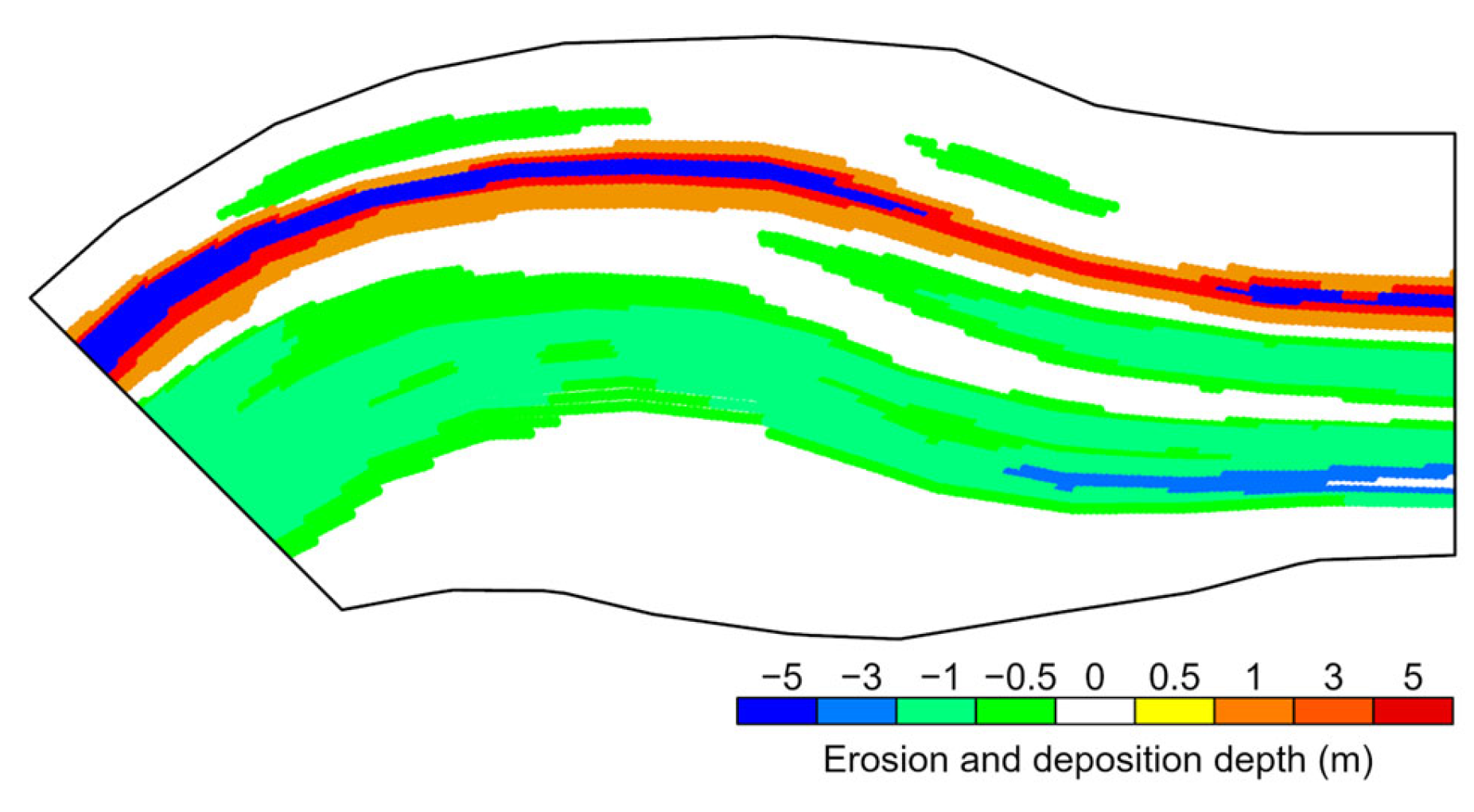
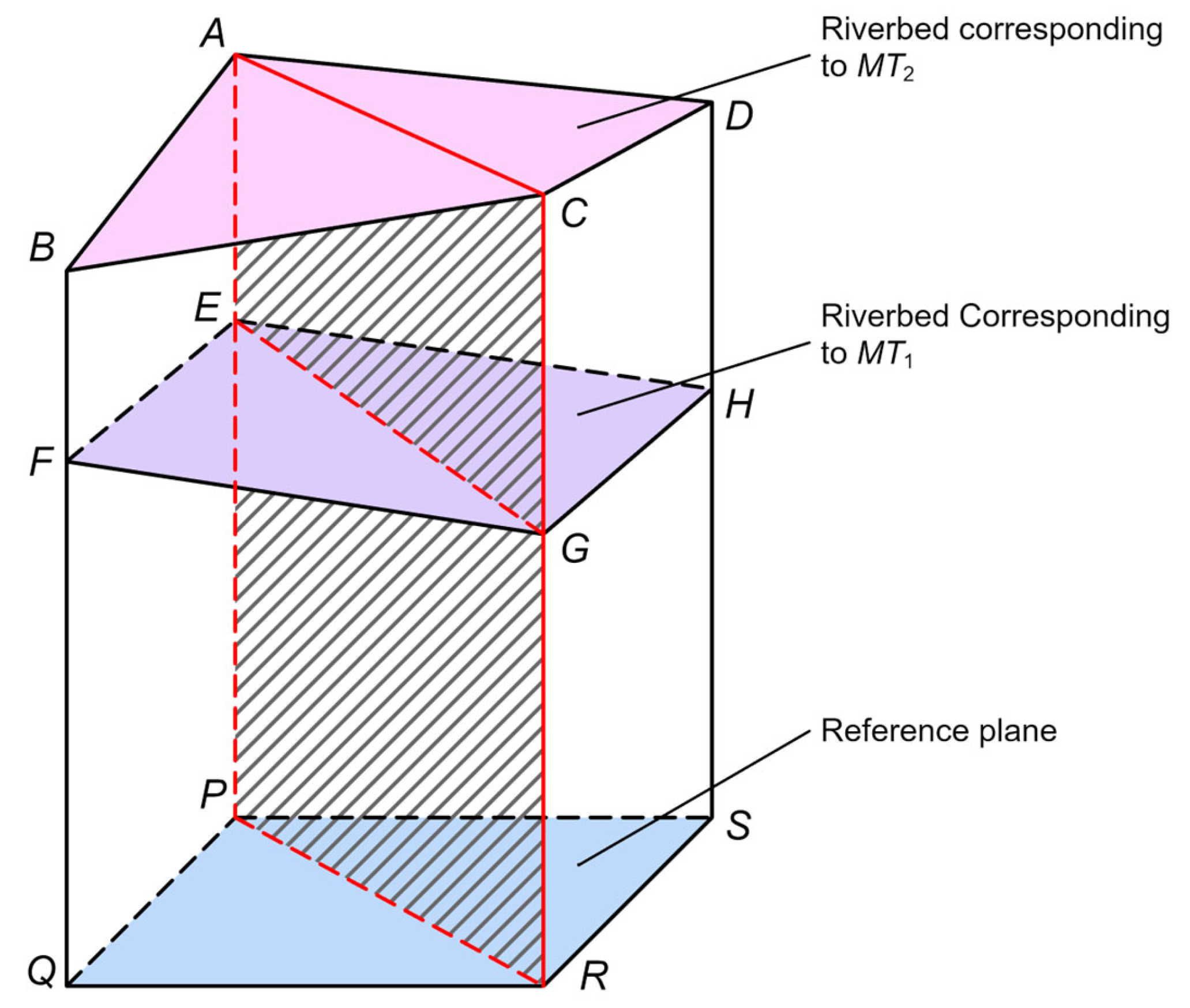
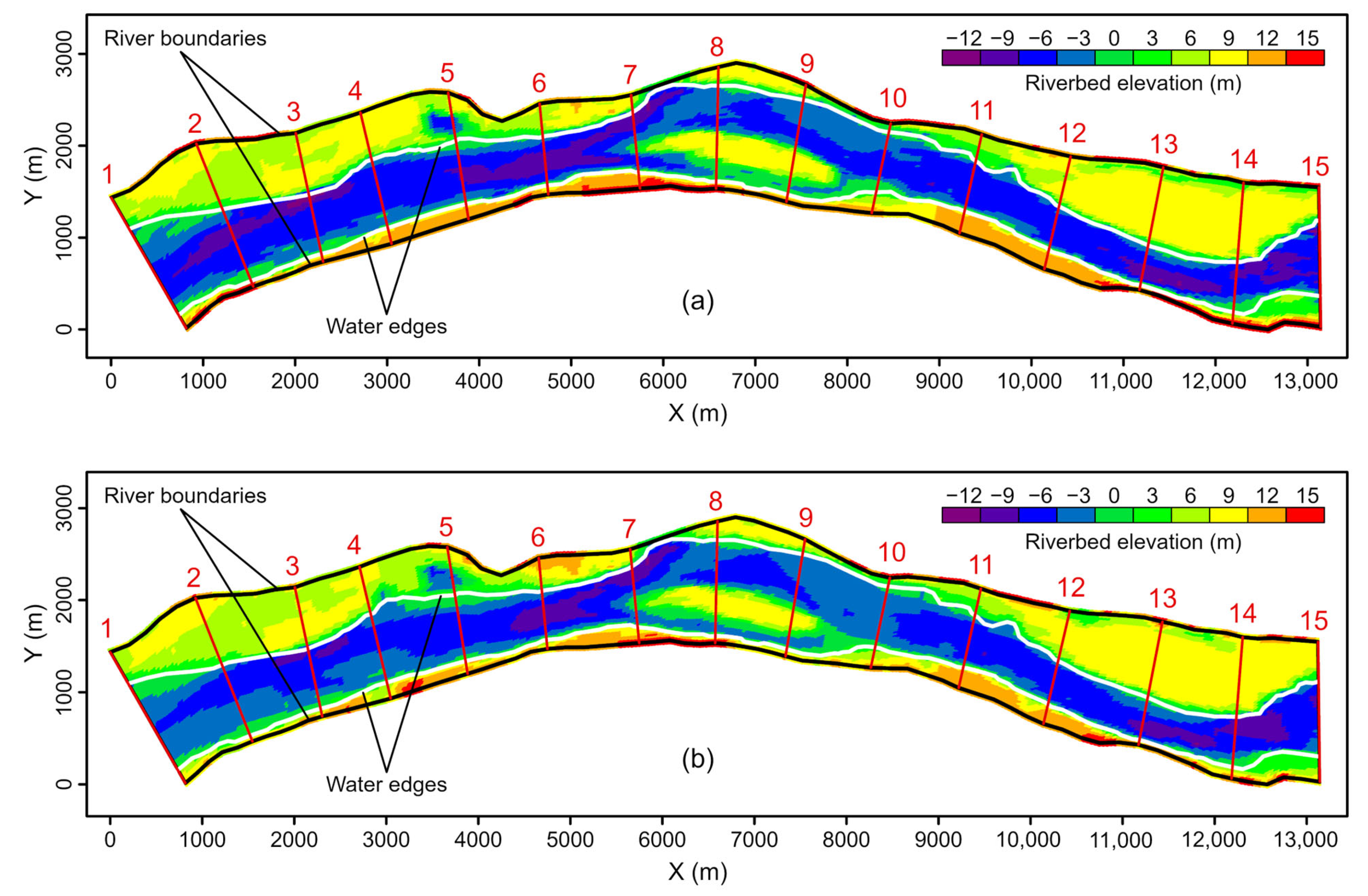

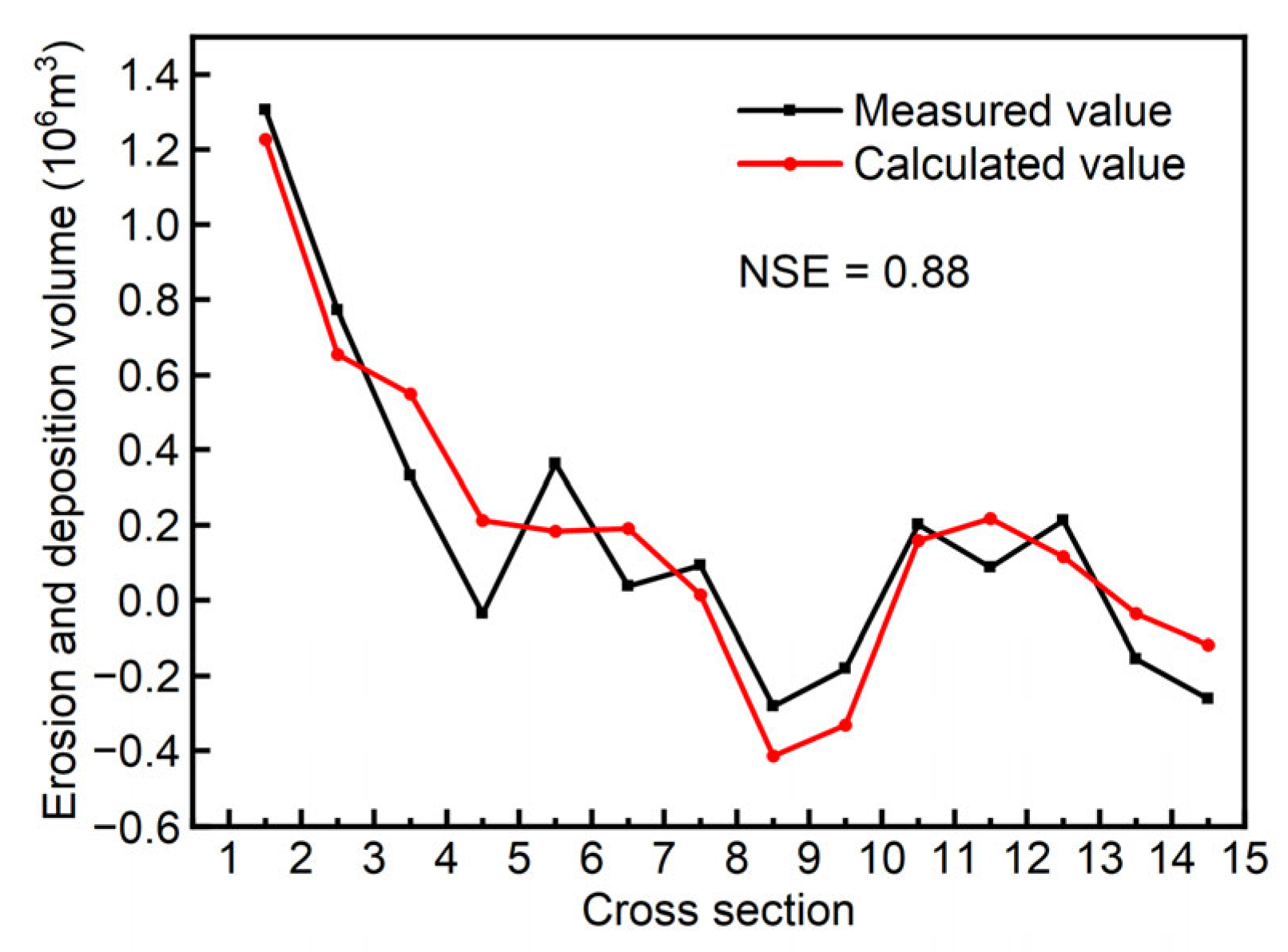



| Vertices | X | Y | Z |
|---|---|---|---|
| A | |||
| B | |||
| C | |||
| D | |||
| E | |||
| F | |||
| G | |||
| H |
| Method | Total Erosion and Deposition Volume | |||
|---|---|---|---|---|
| Calculated Value (106 m3) | Measured Value (106 m3) | Absolute Error 1 (106 m3) | Relative Error 2 (%) | |
| Cross-section method | 2.961 | 2.485 | 0.476 | 19.2 |
| Method in this paper | 2.625 | 0.140 | 5.6 | |
| The Average Grid Size (m) | Total Erosion and Deposition Volume | |||
|---|---|---|---|---|
| Calculated Value (106 m3) | Measured Value (106 m3) | Absolute Error 1 (106 m3) | Relative Error 2 (%) | |
| 80 | 3.021 | 2.485 | 0.536 | 21.6 |
| 40 | 2.886 | 0.401 | 16.1 | |
| 20 | 2.715 | 0.230 | 9.3 | |
| 10 | 2.624 | 0.139 | 5.6 | |
| 5 | 2.625 | 0.140 | 5.6 | |
| 3 | 2.625 | 0.140 | 5.6 | |
| 1 | 2.625 | 0.140 | 5.6 | |
| Number of Cross-Sections | ADAS (km) | Total Erosion and Deposition Volume | |||
|---|---|---|---|---|---|
| Calculated Value (106 m3) | Measured Value (106 m3) | Absolute Error 1 (106 m3) | Relative Error 2 (%) | ||
| 15 | 1.0 | 2.625 | 2.485 | 0.140 | 5.6 |
| 19 | 0.8 | 2.605 | 0.120 | 4.8 | |
| 24 | 0.6 | 2.397 | −0.088 | −3.5 | |
| 36 | 0.4 | 2.423 | −0.062 | −2.5 | |
Disclaimer/Publisher’s Note: The statements, opinions and data contained in all publications are solely those of the individual author(s) and contributor(s) and not of MDPI and/or the editor(s). MDPI and/or the editor(s) disclaim responsibility for any injury to people or property resulting from any ideas, methods, instructions or products referred to in the content. |
© 2023 by the authors. Licensee MDPI, Basel, Switzerland. This article is an open access article distributed under the terms and conditions of the Creative Commons Attribution (CC BY) license (https://creativecommons.org/licenses/by/4.0/).
Share and Cite
Zhang, X.; Bi, Z.; Liu, J.; Xu, Z.; Guo, X. A Method for Riverway Erosion and Deposition Calculation Using Measured Cross-Sections. Water 2024, 16, 132. https://doi.org/10.3390/w16010132
Zhang X, Bi Z, Liu J, Xu Z, Guo X. A Method for Riverway Erosion and Deposition Calculation Using Measured Cross-Sections. Water. 2024; 16(1):132. https://doi.org/10.3390/w16010132
Chicago/Turabian StyleZhang, Xiaolei, Zhengzheng Bi, Junguo Liu, Zhiheng Xu, and Xiaoyi Guo. 2024. "A Method for Riverway Erosion and Deposition Calculation Using Measured Cross-Sections" Water 16, no. 1: 132. https://doi.org/10.3390/w16010132
APA StyleZhang, X., Bi, Z., Liu, J., Xu, Z., & Guo, X. (2024). A Method for Riverway Erosion and Deposition Calculation Using Measured Cross-Sections. Water, 16(1), 132. https://doi.org/10.3390/w16010132







